In 2011, Charlie Noble explained the work done by DNEG on Captain America: The First Avenger. He then worked on several films such as Exodus: Gods and Kings, Bridge of Spies, Jason Bourne and Wonder Woman 1984.
In 2017, Jonathan Fawkner talked to us about the work made by Framestore on Thor: Ragnarok. Then he went to work on Pokémon: Detective Pikachu and The Suicide Squad.
Joel Green started his career in visual effects at DNEG in 2006. He has worked on many shows including John Carter, Godzilla, Spectre and The Kid Who Would Be King.
How did you get involved on this movie and how did it feel to be back in the James Bond universe?
I was brought on by VFX Producer Dan Barrow who had been on the project since August 2018. He and I had worked together previously on Captain Phillips and Jason Bourne. I jumped at the chance to work with him again. We brought in Richard Bain to supervise 2U – we’ve worked together for over 30 years! And then Jonathan Fawkner in post to split the work between myself and him to deal with the fairly tight post schedule.
How was the collaboration with Director Cary Joji Fukunaga and what was his approach and expectations about the visual effects?
I really enjoyed working with Cary, he’s an extremely talented director, a very approachable and likeable chap. His overarching goal was to shoot as much as was practicable for real and for any visual effects to be photoreal.
How was the collaboration with VFX Joel Green and his teams at DNEG?
I’ve known Joel for 15 years. It was reassuring to know the work was in such safe hands.
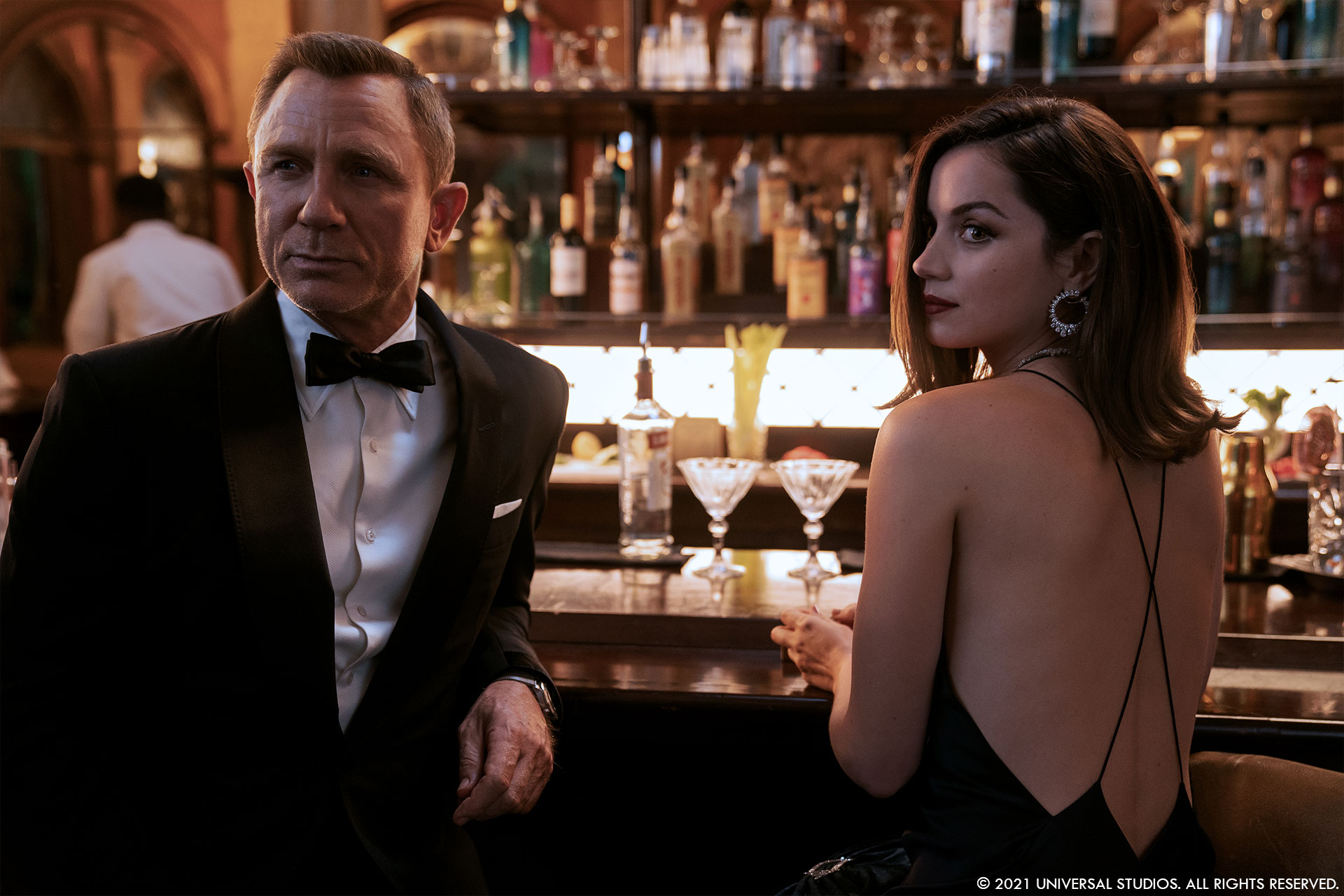
Like every James Bond, the movie is full of impressive stunts. How did you work with the stunt team and which was the most complicated?
The lasting impression from working on NTTD was the overarching desire to achieve as much as was practically possible in camera from all departments. None more so than Lee Morrison and Olivier Schneider’s stunt team. Each department took their craft as far as was possible, from Mark’s sumptuous sets both on location and at Pinewood, through to Lee’s amazing stunt work. I saw VFX as an extension of their craft. It was a deeply rewarding collaborative experience. I’ll let Lee answer as to which was the most complicated piece for him but from a VFX standpoint the escape from Madeline’s Norway safehouse probably pips it.
How did you create the digital doubles and especially James Bond?
We had limited requirement for close digi-doubles of the principles as we had good stunt doubles which required face reps where necessary. Having said that, principles, stunt performers and extras for crowd addition were body scanned in each costume by ClearAngle who had a scanning booth near set at Pinewood. We used digi-doubles in the glider, Bond swimming to the surface away from the sinking trawler, the guards who get blown away in Safin’s lab, one or two crowd digi’s close to speeding cars/riding mopeds, scramblers, crowd extensions in Matera and Safin’s huge « farm » under his lab on the island, Paloma’s legs for some of the high kicks in the Cuba bar fight to connect the hits as well as a face rep or two. As Daniel was in L.A during pre-production, we took the opportunity to scan him at USC’s Institute for Creative Technologies which allowed ILM to start work prior to principle photography. Once we had an edit assembly, we took principles to ILM’s Medusa and Anyma stage in Chiswick to refine the heads and capture performances based on the various stunts.
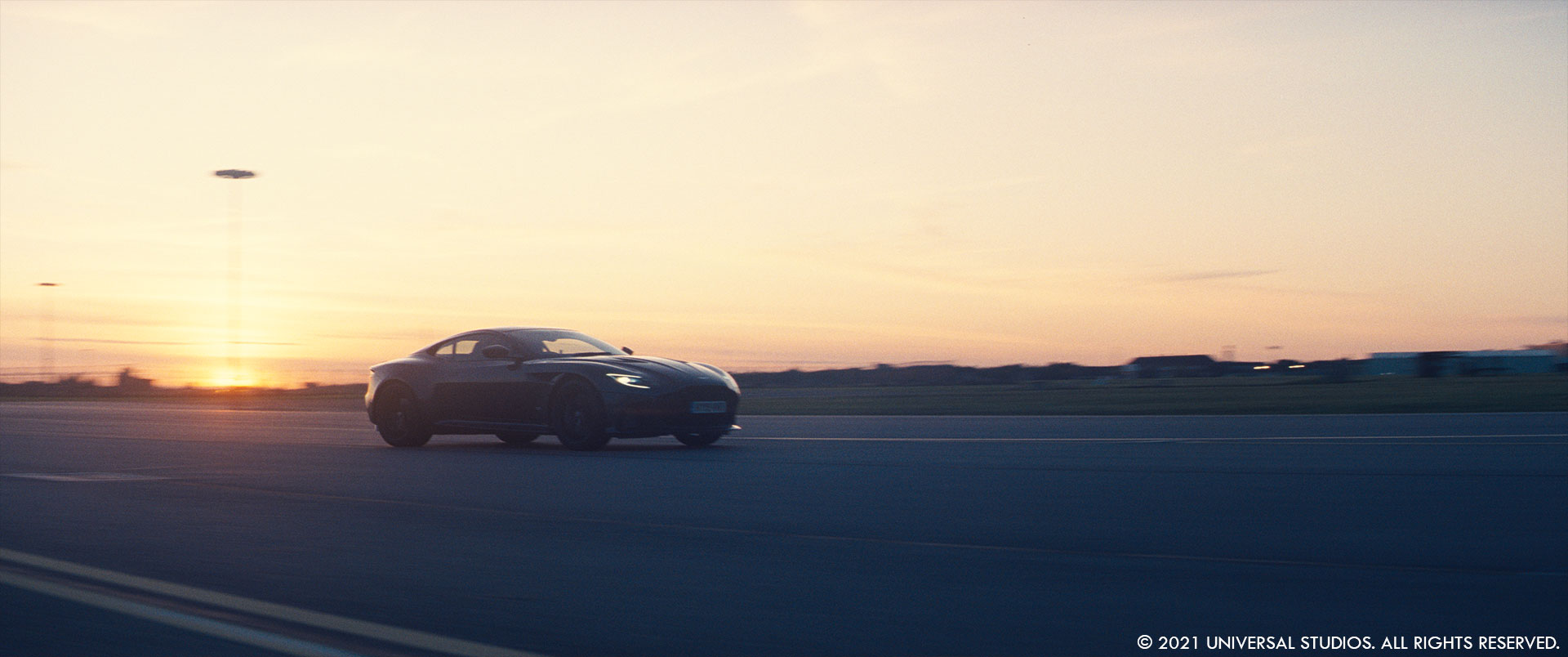
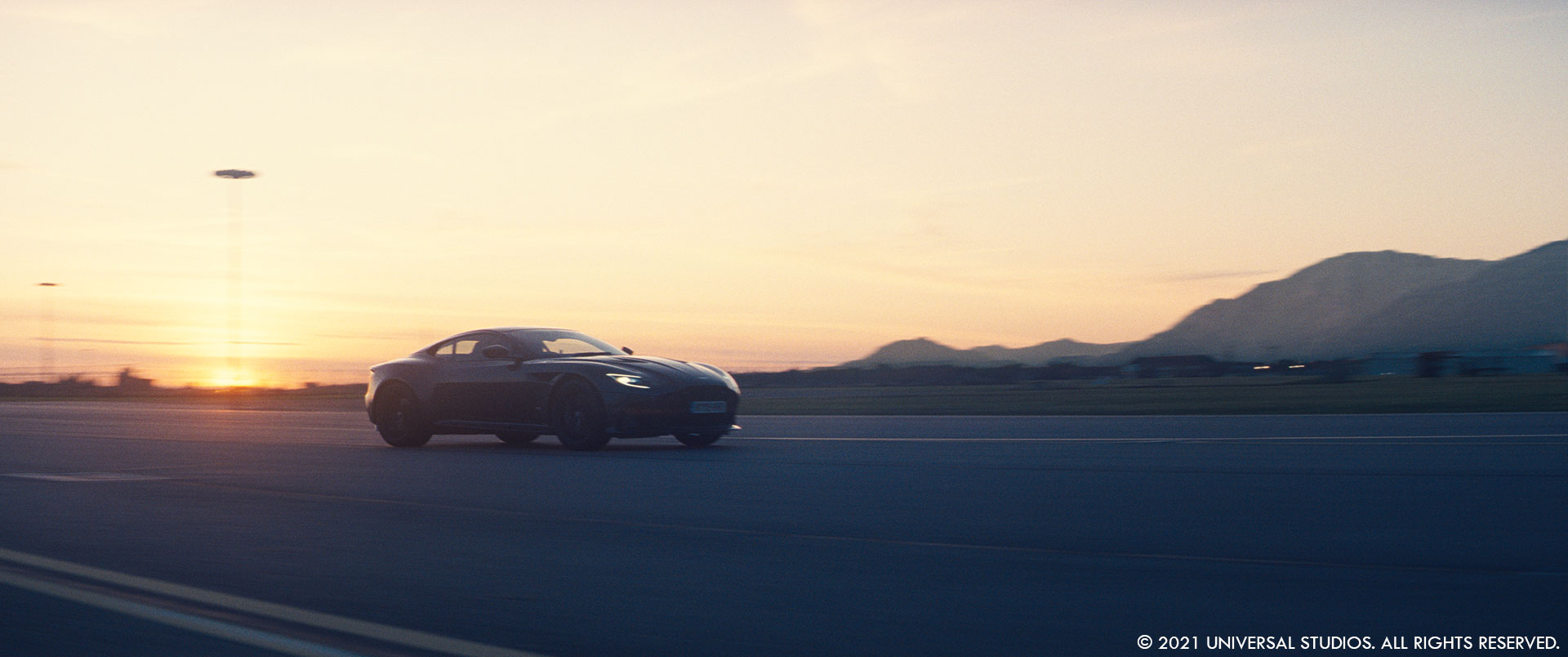
The film visits many exotic locations. Where were the various exteriors in the movie filmed?
Norway, Matera in Italy, Jamaica, Scotland, London, various other UK locations in the Southeast and the Faroe Islands which stood in for Safin’s lair. Additionally, a VFX unit visited Cuba to shoot stills and drone footage to establish and enhance the Cuban sequences.
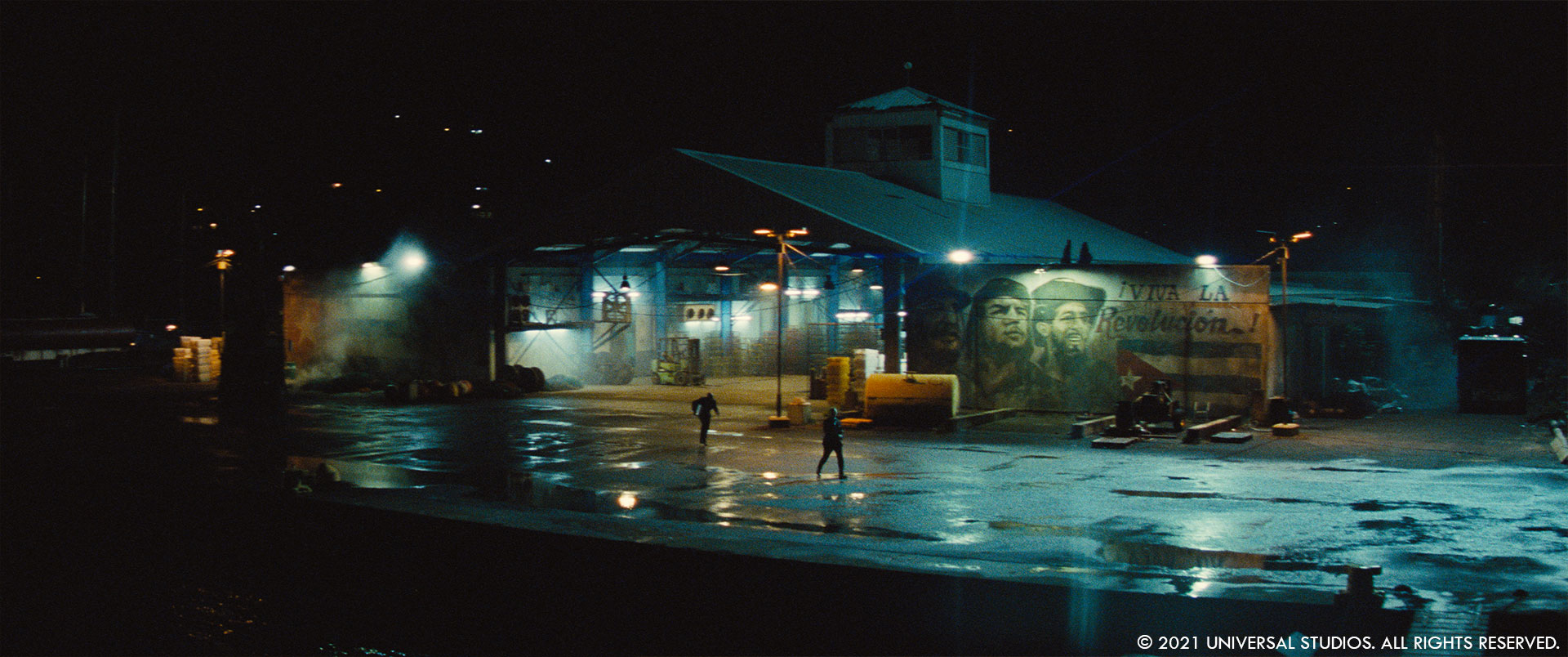
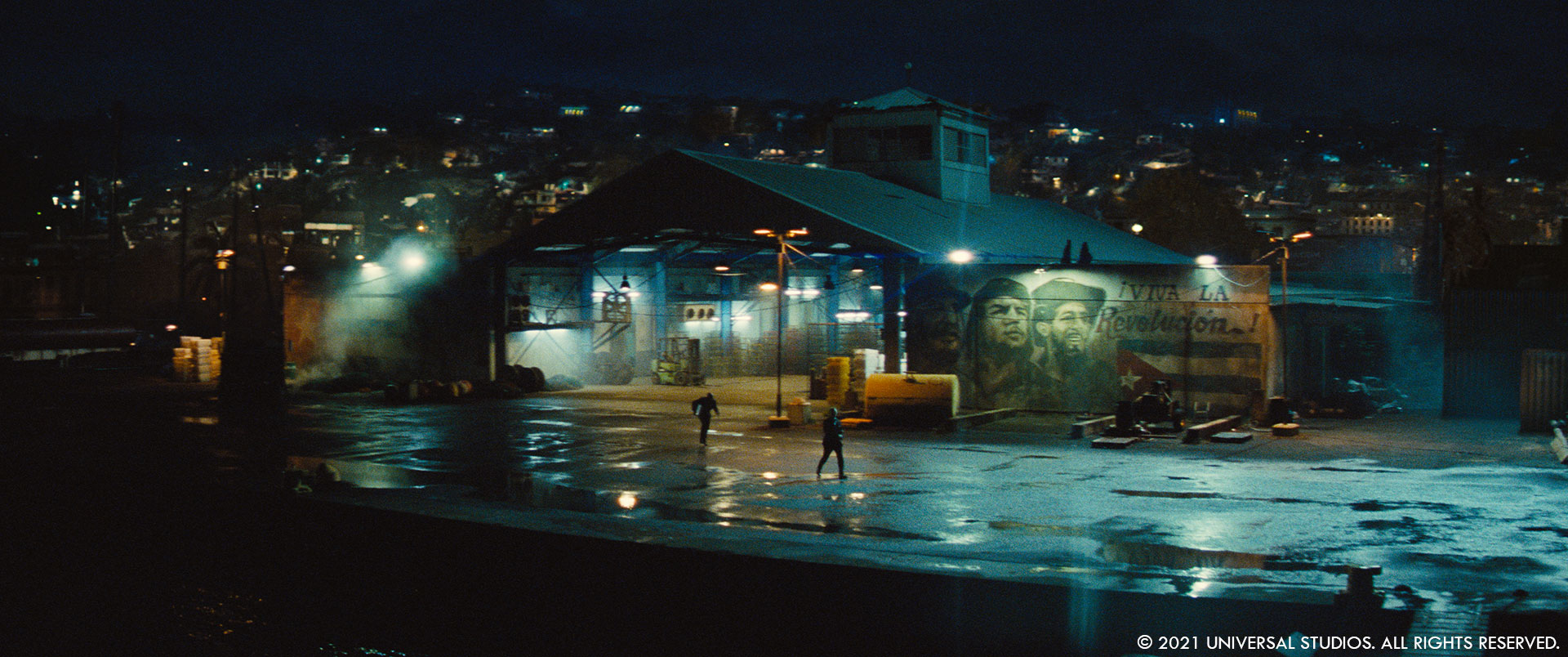
Can you tell us more about the shooting of the frozen lake and your work on this sequence?
Charlie Noble // The film opens on a lone sinister figure trudging through the snowy forest towards a remote and isolated house on the shore of a frozen lake. Once the location was picked, Steve Bohan’s crew got to work constructing Mark’s design for the house on the ice, supported by piles through the ice. It was a fully functioning set, inside and out, in a stunning location. We had a fairly narrow window to shoot as the weather warmed and the ice was constantly checked for stability. It set the tone for the movie: IMAX cameras out on the ice, in the middle of nowhere, filming some gorgeous scenery. Cary’s aim was to have the lake covered by thick, totally clear “steel” ice and to this end the art department had an ice rink machine constantly polishing the ice in an attempt to brush away the white crusty top surface. This was successful to a degree but for key closer shots out on the ice, we ended up replacing the ice with our CG build. Shooting outside came with the usual challenges of changeable weather. The favoured look for the exterior had a pre-dawn, misty feel to it. To supply the required atmosphere, Chris Corbould’s VFX crew assembled as many smoke machines as I’ve seen! Some of the trucks were over 1/2 a mile away and gave us some beautiful cover. With changeable wind speed, the cover inevitably varied across the shots. As did the light, ice and snow cover on the trees. We had our scanning/photography team from Lidar Lounge with us at all locations and they brought back a ton of data to help Framestore work their magic in post.
Jonathan Fawkner // I think throughout the movie we were very keen to keep the integrity of the scene and composition even though we were replacing a lot. So a lot of attention was given to replacing like for like. For the Norway sequence, February still photography was super useful, including from various drone positions enabling a good line up to the non-winterised trees in the plates we would eventually shoot months later when the thaw had started. We created a beautiful render of a steel-ice lake with deep cracks that could take advantage of the parallax in the camera. CG snow and matte painted elements combined to give the real Norwegian lake location a deep lustre that it was buried under snow when we shot.
Matching the lighting conditions was important and that meant grading some of the plates substantially. We set the conditions based on one key shot which had pre-dawn lighting and then used a Forecast (physical environment) render for every shot to get continuity. For the high wide shots (looking away from the established dawn) we cheated the sky around until it gave us the best combination of reflections on the ice and separation on the hills, while staying true to a photographic reality and as close to scene continuity as would not be off-putting. Faking the conditions to suit our camera position We then affected a matte painting that matched those generated conditions.
Charlie Noble // Shots of young Madeline falling through a thin patch of ice were a combination of stunt performer dropping into the actual frozen lake on location and closer shots of the actress dropping into a set piece surrounded by blue screen on the Pinewood backlot. Tighter shots looking down at the actress under the ice were shot on Pinewood’s U-stage, with her under huge, thick slabs of actual ice shipped over from the Norwegian lake. There was obviously a narrow window for takes as the water had to be warm enough to work in, yet not too warm as to give us some time with the ice.
Shots under the ice were with a stunt double under large clear Perspex sheets. Linus and Cary provided great reference for the underwater look which Framestore took and created the environment we see in the wide as Safin shoots through the ice, adding the bullet bubble trails that surround the flailing Madeline.
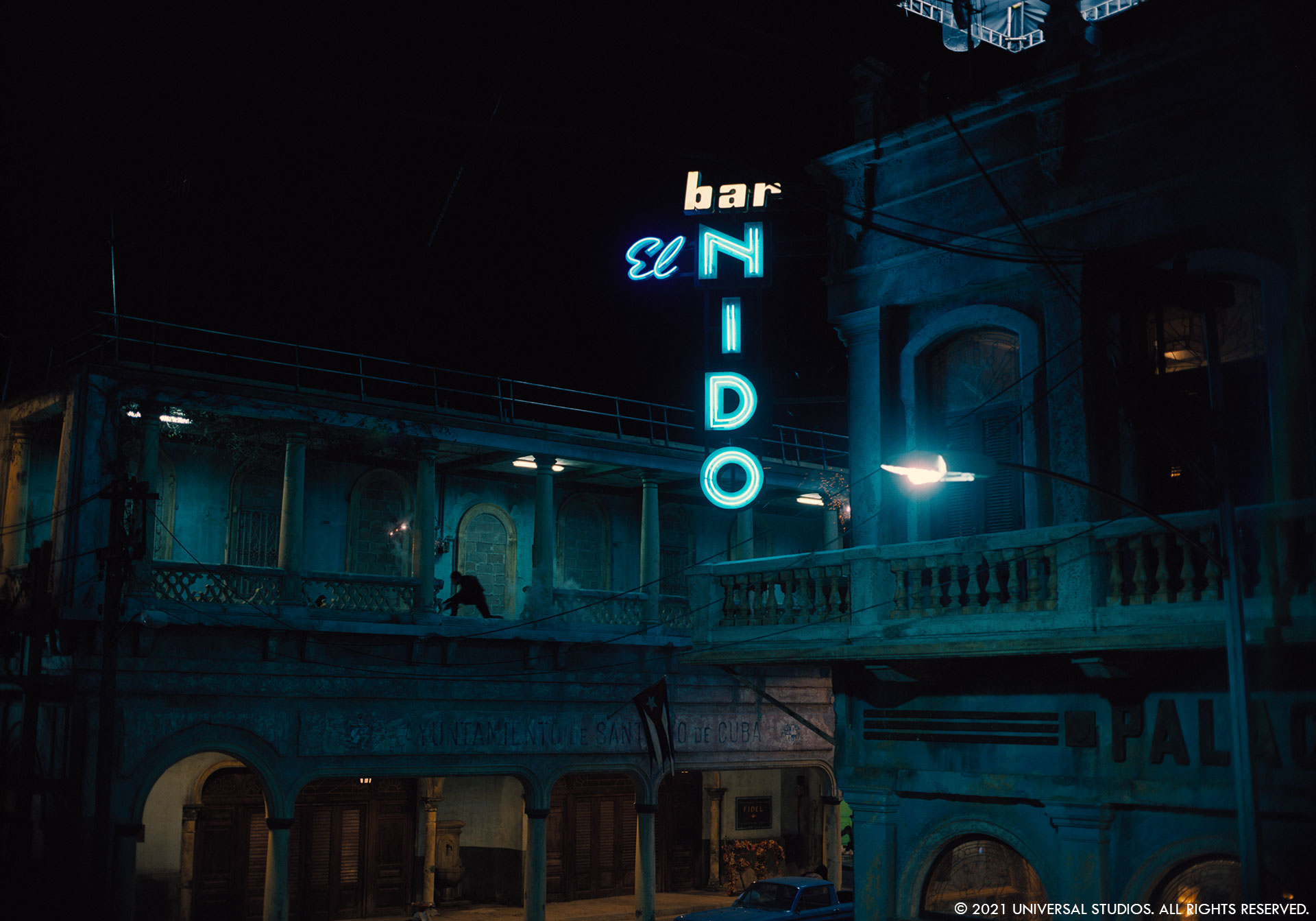
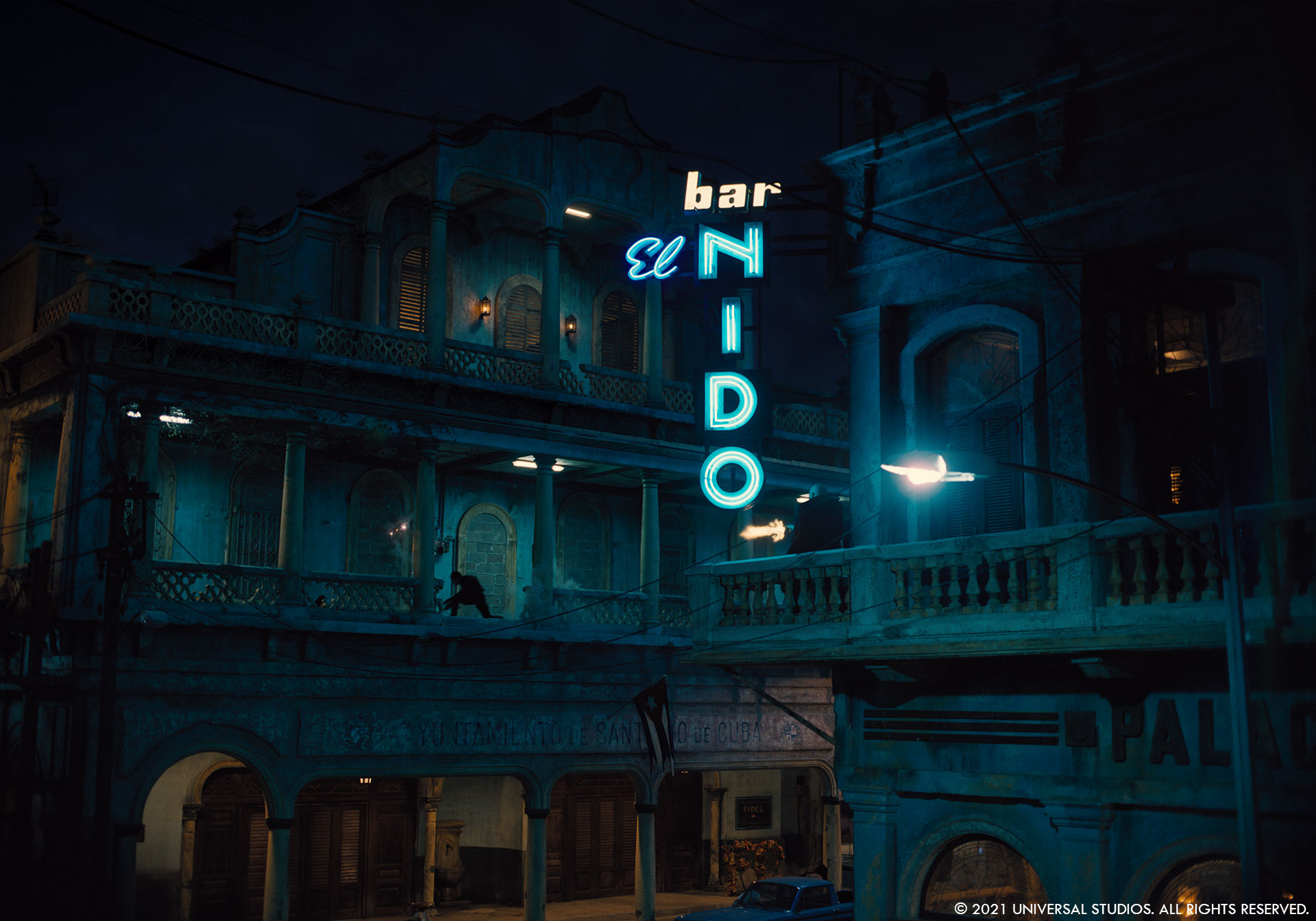
What are the main challenges to filmed action sequences in an old city like Matera?
Getting permission to film an action movie such as this in one of the oldest continually inhabited settlements in the world was clearly no mean feat and I’d imagine that the main challenges were felt most by Ben Piltz and his location department. Keeping the authorities onside during the filming of high-speed car chases and explosions deserves a medal. Beautiful as it is, the town itself didn’t lend itself to the practicalities of filmmaking. Narrow streets that evolved to accommodate nothing wider or faster than four legged beasts of burden, not high-speed tracking vehicles and crew trucks. The well-worn (polished) limestone streets also proved challenging for the car/bike chase sequence and Lee employed a trick I’d not seen before – spraying the streets with gallons of actual Coca-Cola which dried to a nice tacky finish and gave the tyres the purchase they needed. It certainly worked and was then washed off once we’d done for the day.
A few of the big stunts required large cranes for rigging and/or wire-cam. The siting of these was tricky enough with the narrow inaccessible streets, further complicated by the fact that the whole town is one big honeycomb of ancient subterranean dwellings, so each position had to be carefully surveyed and braced where necessary.
For us, the bulk of the shots involved clean-up to various extents. 21st Century clutter, satellite dishes, construction cranes, stunt rigs etc. The car work unsurprisingly laid down a lot of rubber on the streets which was cleaned off as much as possible overnight but from take to take there was considerable build-up for us to clean up.
One slight geographical cheat had us bring a medieval bridge from the neighbouring town of Gravina and place it in the deep gorge that borders the East side of the town. Bond visits Vesper’s tomb and to get there he crosses the bridge. We scanned, textured, and shot plates of the bridge in Gravina and Mark Bakowski’s team at ILM built an asset that included the bridge, trees, and surrounding topography. For shots in Matera, we added the bridge to the gorge and for the shots on and around the bridge in Gravina we added Matera from plate photography, re-projected onto our model of the town.
On the bridge we see Bond, ears ringing from the tomb explosion, pursued by Spectre (in effect Safin’s) agents. ILM added close masonry hits to the walls, replaced the stunt rider’s face with Dali’s, added Matera in the BG and a CG Lancia that hits a low buttress and flies over Bond as he rolls to the ground behind the buttress. The stomach-churning leap from the bridge was performed by David Grant who’s face we swapped out for Daniel’s up until he hits the dirt under the bridge. One or two close shots of Daniel making the initial leap were shot on a small set piece back at Pinewood.
Which location was the most complicated to enhance?
Charlie Noble // Probably a tie between the Glider approach to Safin’s island and the escape from Madeline’s lake-house which had us combine shots from 7 locations; the family leaving a partial house set built in Ascot, the start of the pursuit down the Atlantic highway in Norway, followed by the chase along the shore of Loch Laggan in Scotland, shots from Salisbury Plain of the defenders breaking out of the woods, down a river bed on the Ardverike Estate in Scotland, back to Ascot as the Landcruiser attempts to hide in the foggy woods and then back to Scotland for the shots of Safin flying off in his helicopter and Nomi picking up Bond from the side of the road in a CG Aston Martin DBS, which was felt to be more suitable than the Valhalla that we had on-set. Each required elements of each other for continuity.
The whole chase was a stunt and SFX spectacular with us providing support for clean-up, continuity, and added jeopardy. The final defender flip at the end of the chase was a practical SFX stunt shot with a motion control rig from Ian Menzies to allow us to repeat the move safely with Daniel. The vehicle had to flip, twist and roll over, arrested by a pine tree. It was a one take deal and worked perfectly considering that it was nearly 3 tons of flying metal in a tight space. We switched to a CG version of the car at the end of the shot to get it into its required final resting position against a CG tree.
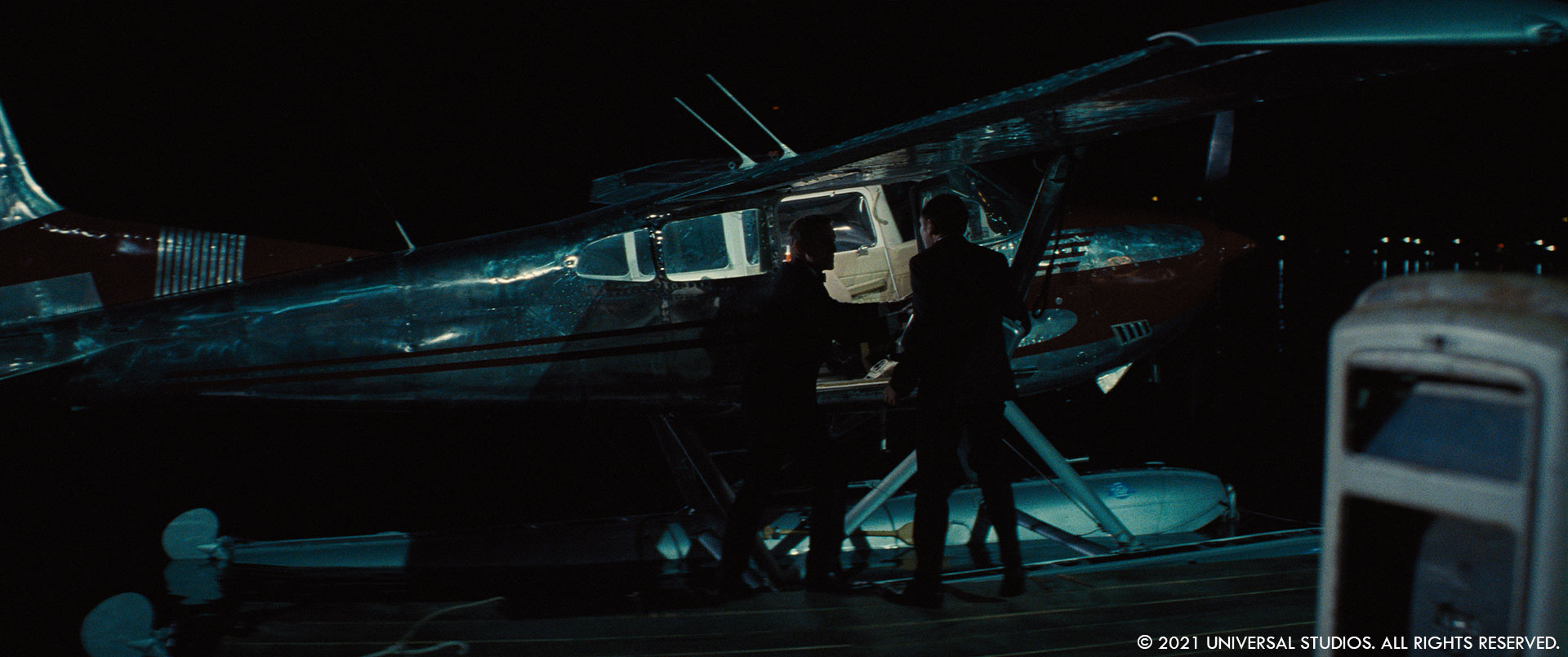
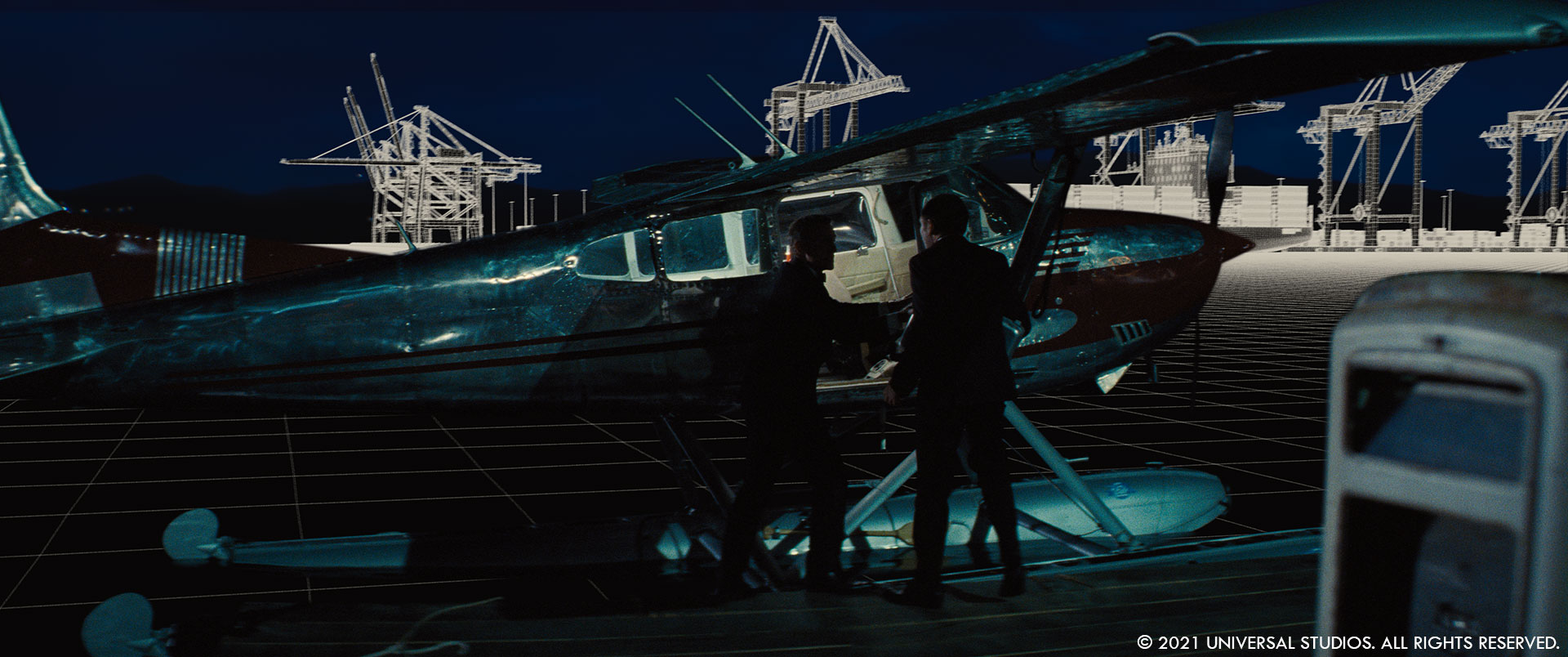
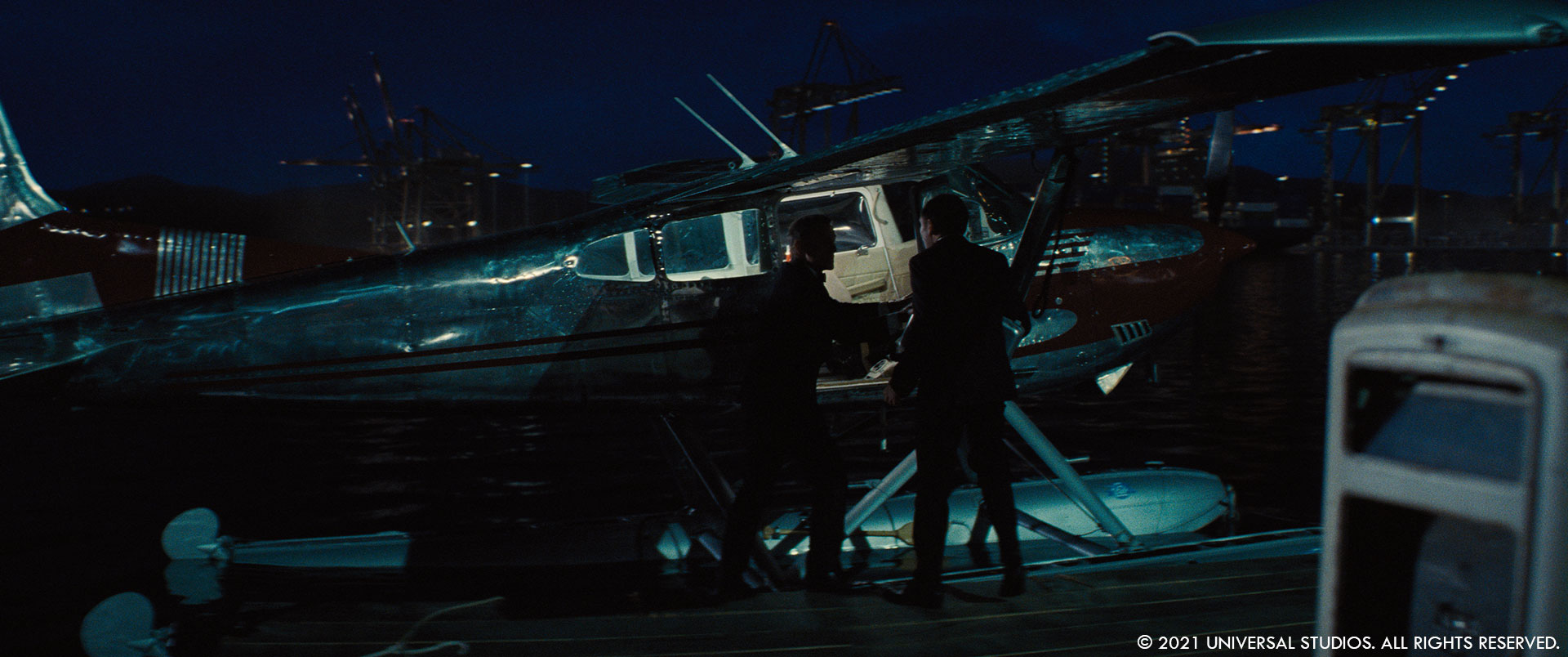
Jonathan Fawkner // The DBS was a late addition to replace the Valhalla which was slightly incongruous driving down the rough forestry tracks. Again, driven by the Weightshift AI suspension, we matched the DBS to the footprint of the Valkyrie, meaning for the most part the dust kicks could be retained from the plate, and the new CG DBS placed on top. We used Nomi and Bond plates from other scenes to add the driver and passenger for head on shots. It is a much larger vehicle with bigger windows, so we had to rebuild parts of Nomi’s costume and hands for when she is photographed in close-up through the open window. The paint and finish on the car were extremely complex. The ‘flop’ effect produces very different colours depending on the angle to camera.
Our Norway car chase needed considerable repair due to the damage caused by multiple takes of Land Rover’s driving over wet ground. Additionally, edit changes meant we needed to reposition the vehicle for continuity, involving completely removing and reanimating vehicles. Additional photography on Salisbury plain also required work to match the Scotland location, in most cases necessitating a complete rebuild of a shot, including FG grass and replacing Land Rover’s, using Weightshift AI suspension, adding bikes and mud spray as well as interactive trees and BG matte painting, but maintaining the truth of the stunt and camera work.
Joel Green // For DNEG the work required for the glider sequence meant multiple complex environments. We travelled from high altitude, skimmed over a layer of clouds, dropped down past the island to sea level and then underwater through the course of the sequence. We required lots of full CG shots to tell this story in addition to enhancing various aerial plates shot in the Faroe Islands. For the close-up plates of Bond and Nomi flying the glider we created a single long take of a camera pulling out of the back of the C17 and diving down to the clouds then below to sea level. This 360-degree render was used on LED walls on set to light the actors and provide the travel and fluctuation of lighting that really helped us sell the final shots.
The Aston Martin DB5 has a big moment of glory. How did you help with that?
Again, this was all mainly in-camera stunts and SFX. As with the Landcruiser in Scotland, Lee and Chris built a pod cage on top of the DB5 so we could have the stunt driver on the roof and the actors in the car for the chase. ILM painted out the pods when seen, using scans and clean plates from Matera. For the final escape from Piazza San Giovanni (dubbed « donut square » for the shoot) we added bullet cases ejecting from the side of the car as the mini guns whirl away, some timing tweaks to the practical masonry hits and some additional smoke from the rear of the car to create the desired donut of smoke. The bullet hits to the glass were practical SFX, requiring some tweaks for continuity and one or two interior shots were filmed back at Pinewood.
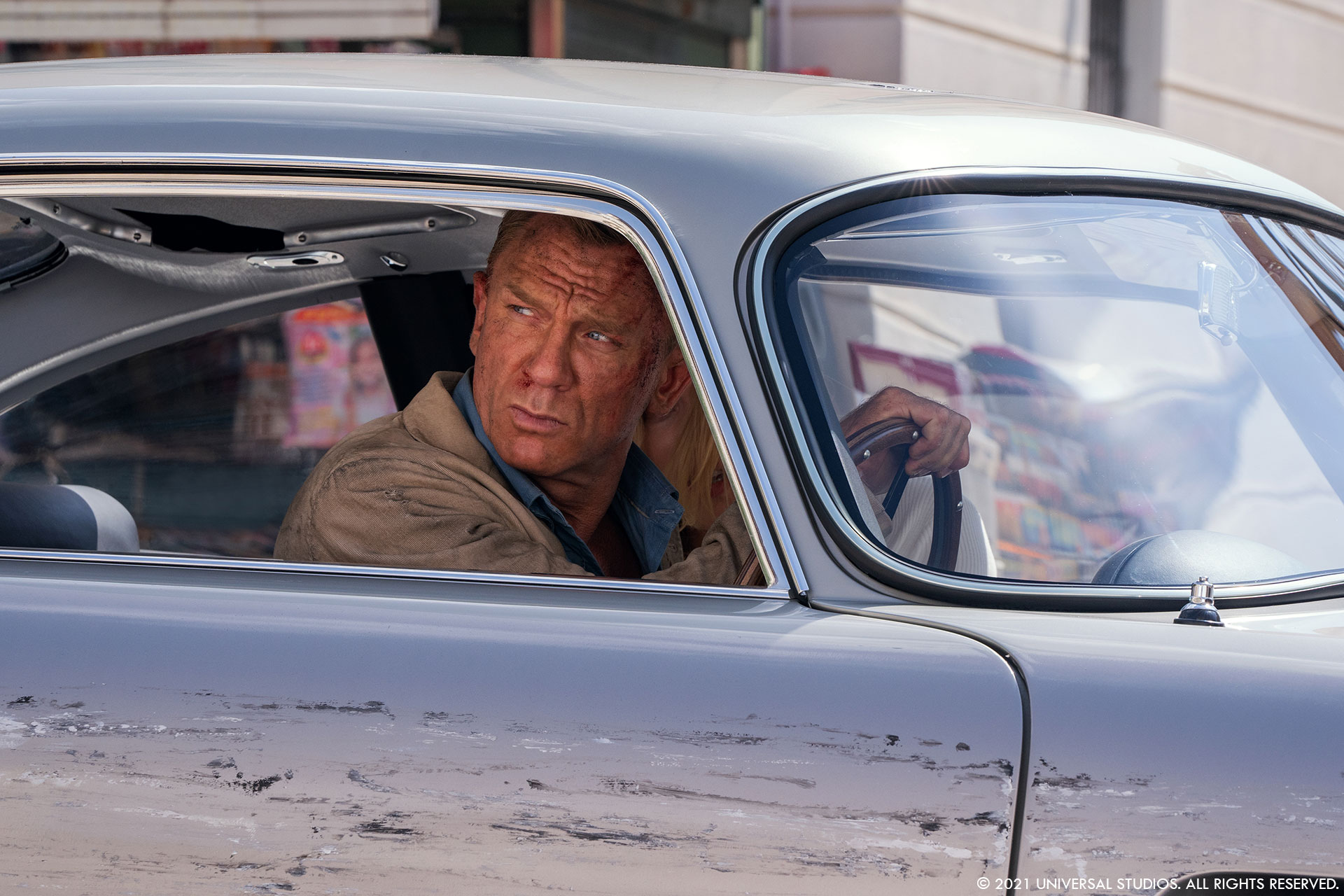
How did you create the tower and the London environment?
The sequence starts with Safin’s agents walking down the plate glass exterior of a tower East of the City. We shot plates from the roof and a descender rig at One Canada Square in Canary Wharf and also aerial plates. Chris Lowe built us a smoked glass set at Pinewood for our agents to walk (abseil) down, shot by 2U guided by previz. Jonathan Fawkner’s team at Framestore took over from there.
Jonathan Fawkner // Helicopter shots taken at dawn were stitched and augmented in comp with moving traffic, trains and life as well as adding interior building lights from reference of the London skyline and then matching the atmospheric distortion. London is much darker at dawn than at dusk! To give Cary the mirror he wanted for the shot we created a CG building with CG interiors. FG elements were taken from buildings in and around Framestore as we look up at the explosion. The fireball got paired down from a Nakatomi plaza event to a much more localised bang.
Charlie Noble // Once inside the Lab DNEG enhanced the laser sight beams coming from the assault weapons, added extra smoke from the initial door break explosion, painted out the SFX charge wiring for the impressive SFX lab explosion, repositioned glass hits, added nanobots swirling in the test-tube that Primo (Dali’s character) extracts, added the CG explosion that roils towards Primo before he jumps down the lift shaft which was a partial set build for the top and bottom, with a CG lift shaft extension to join the two together, along with the spinning bomb that spits out magnetic charges that work to arrest their descent at the bottom.
Joel Green // The lift shaft was a really fun sequence and exactly what you want to be doing on a Bond film with cool gadgets and fireballs. A few floors of the shaft were built at Pinewood, and we extended that to about 40 stories high. The magnet bomb was keyframe animated but we used a procedural setup to eject the magnets in a spiral formation and stick to the walls.
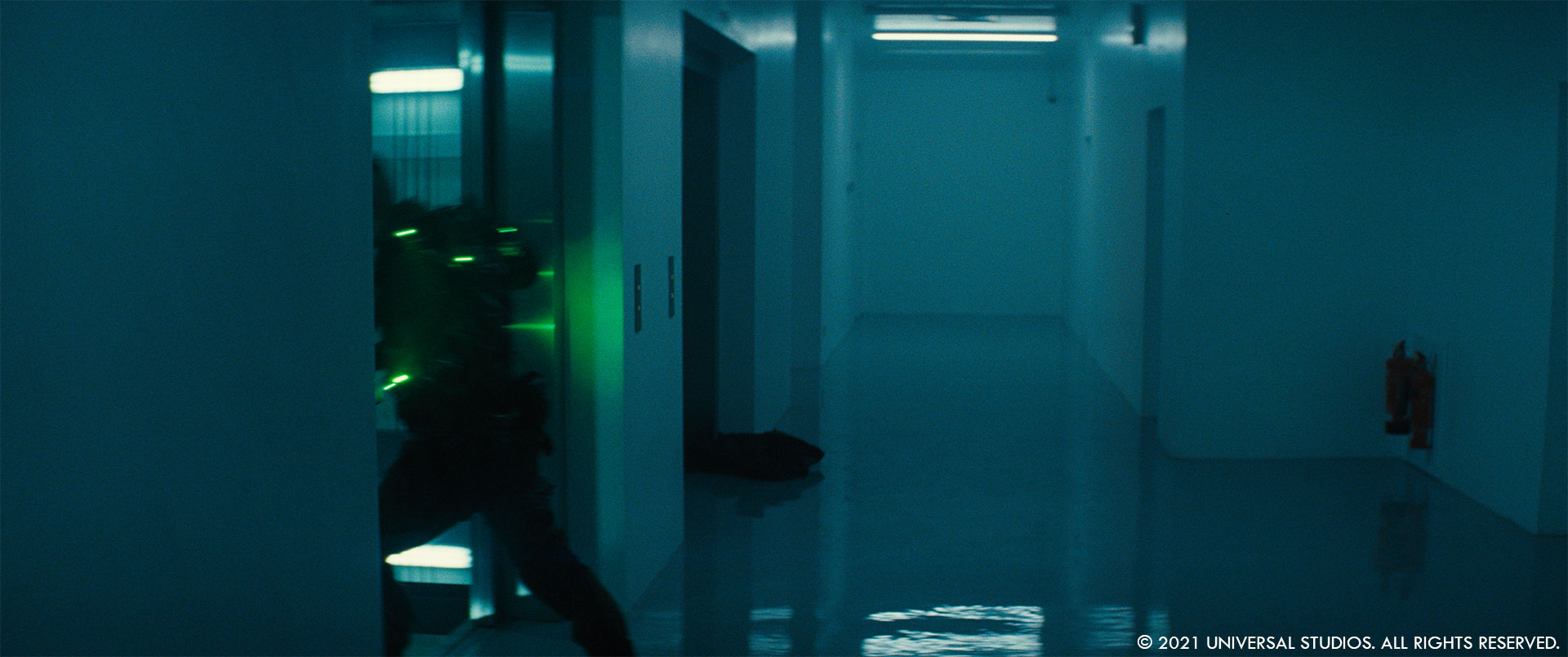
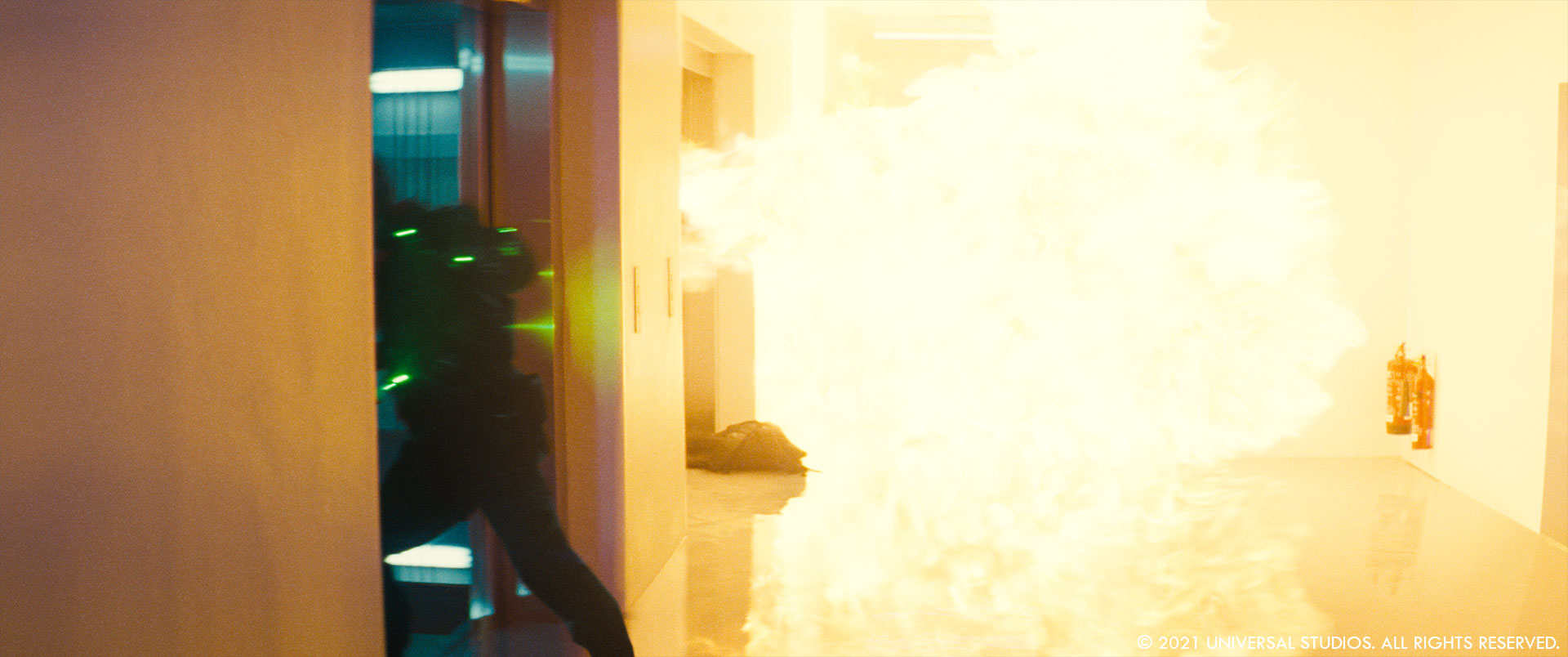
What kind of references and influences did you use for the Safin’s island and his base and can you elaborate on their creation?
Charlie Noble // Cary and Mark provided great references for Safin’s fictional island, part of a small chain in a far-flung part of the world doubled by Kalsoy in the Faroe Islands which we were fortunate to visit twice. The first time was with a survey team equipped with lidar, stills cameras and a drone for aerial photogrammetry. We later returned with 2U to shoot ground plates from selected positions whilst the aerial crew shot plates guided by previz.
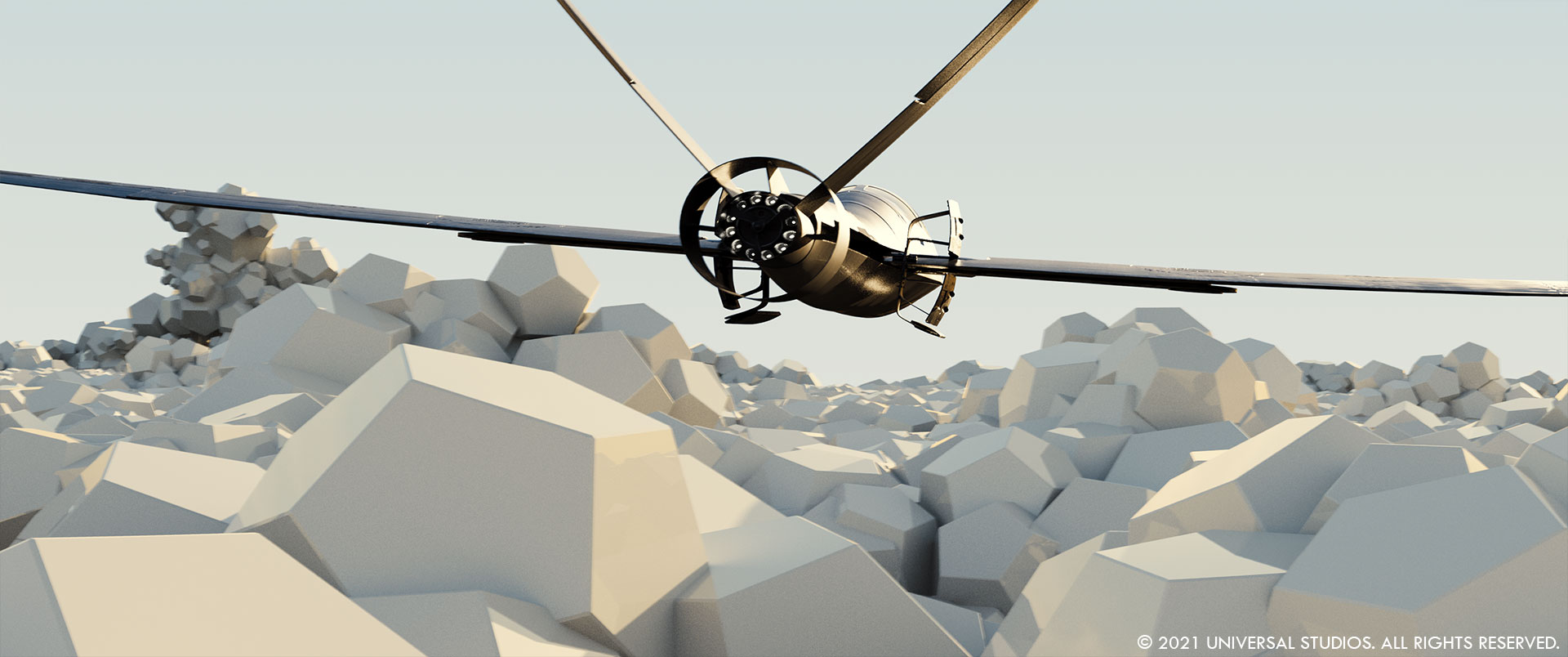
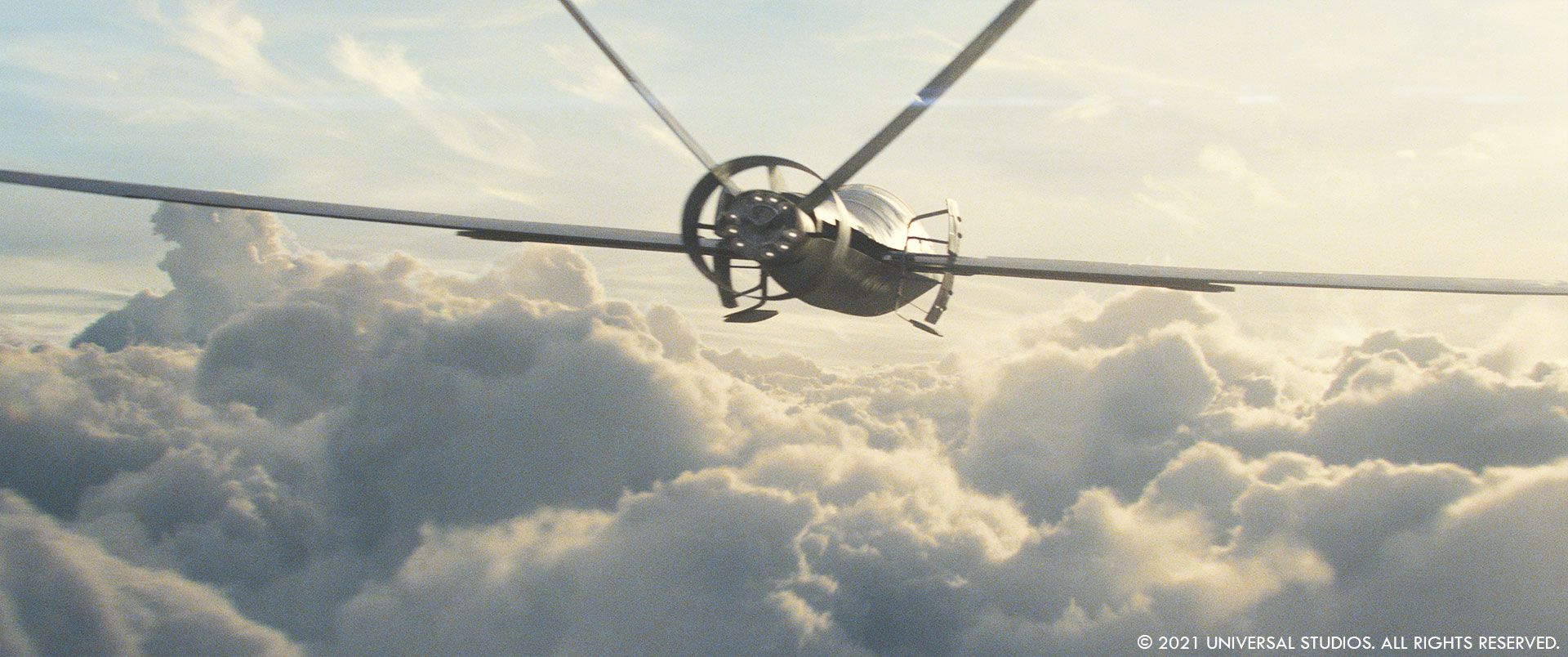
Joel Green // We worked with the local Faroese helicopter team to shoot extensive aerial photogrammetry of the island which was combined with stills taken from a rib boat around the coast to derive a detailed base model of the Northern part of Kalsoy Island. We adjusted the shape of the island, shortening it with CG terrain on the Southern tip. We ended up having to create a 9km long island with a high level of detail across all the surfaces. We altered the real terrain in a number of areas, notably around the hero silos where Safin has his Zen Garden and also around the coast where the factory and port reside. Architecturally, we created a CG factory by the shore, an old Russian sub pen where the glider sub enters, the main silos and various other features including a train network for transporting materials around the base. The art department provided us with great designs for all the buildings and also a full history of the use of the island though the last 100 years!
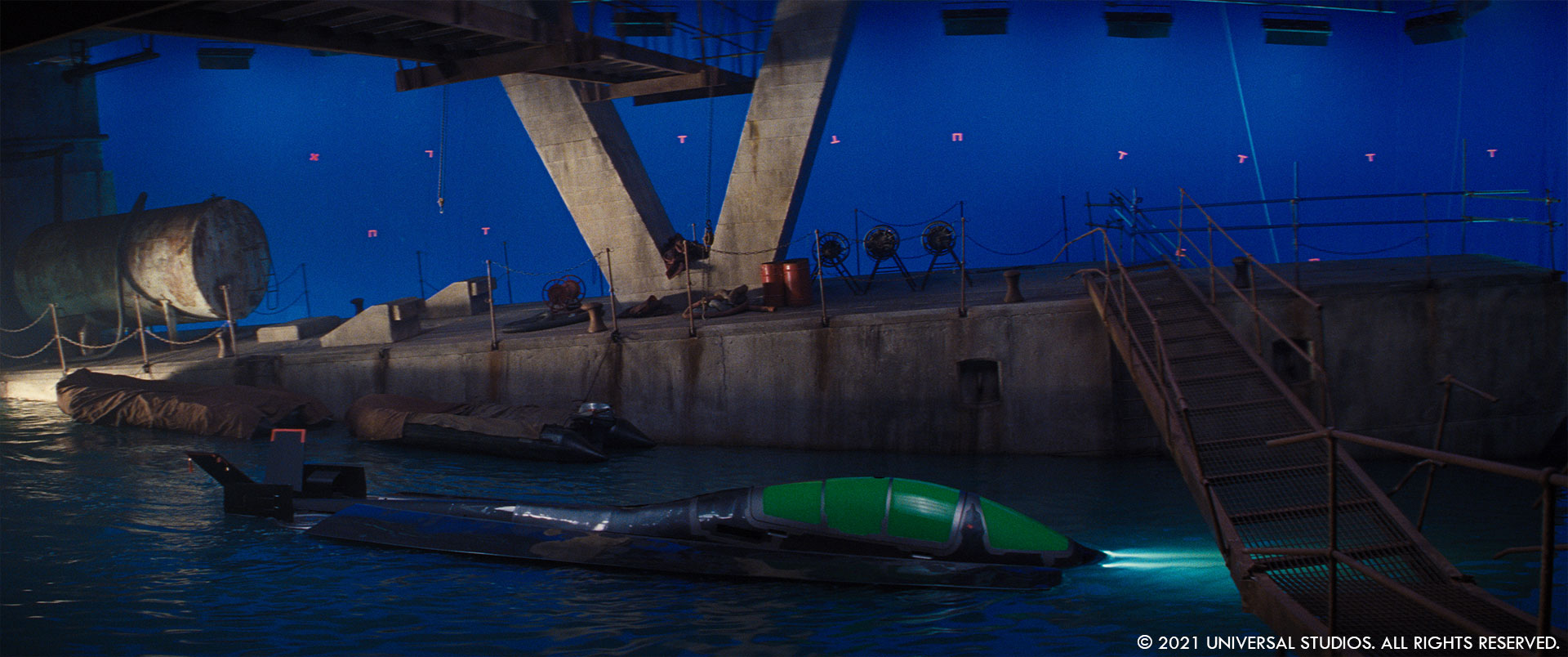
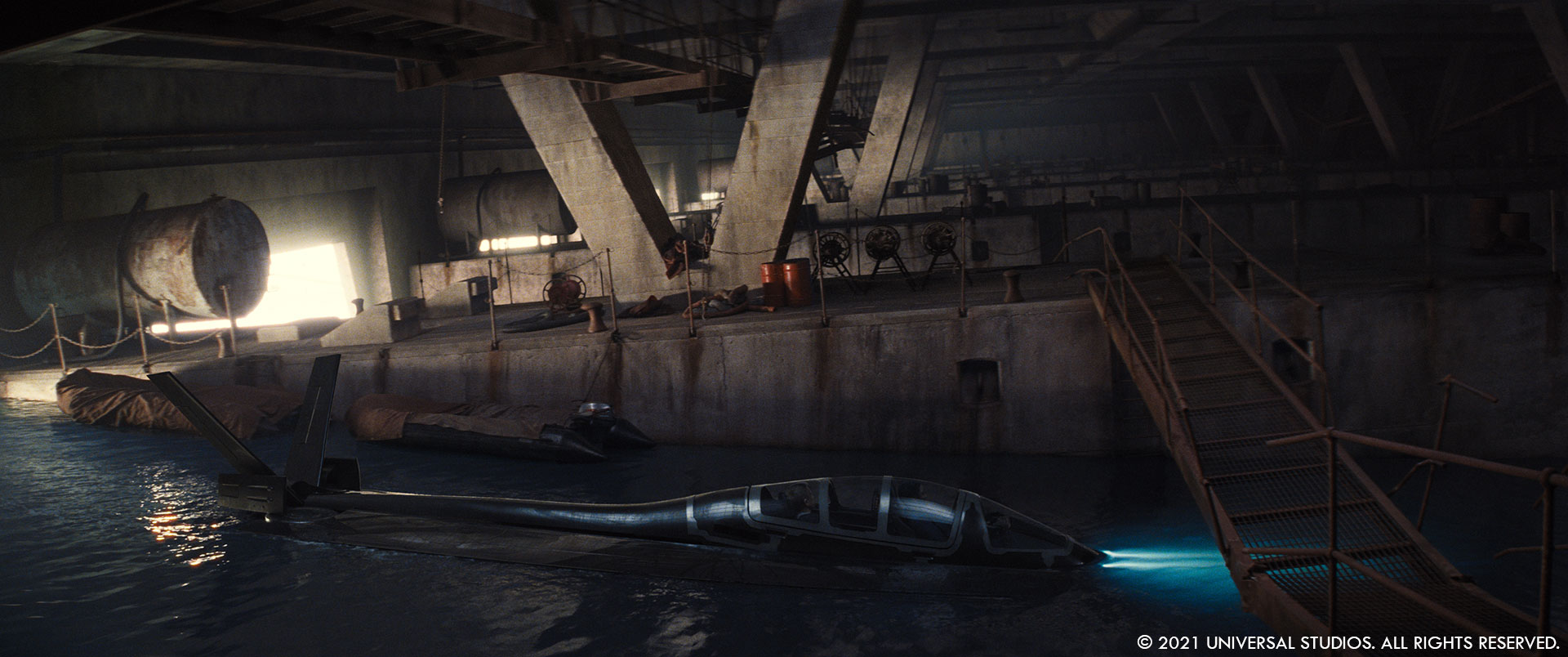
During the final sequence, there is an impressive long shot. Can you elaborate on this shot?
Multiple takes were invisibly split together by a combination of 4 vendors: ILM, Framestore, DNEG and Cinesite, on wipe points provided by close action. A couple of face replacements on Daniel and Dali’s stunt performers as they fall down a flight of stairs, bullet hits to the walls from separate FX passes, CG grenades being thrown up and down, explosion and fire enhancements and views out to the DNEG missile silo asset with Faroe plates beyond.
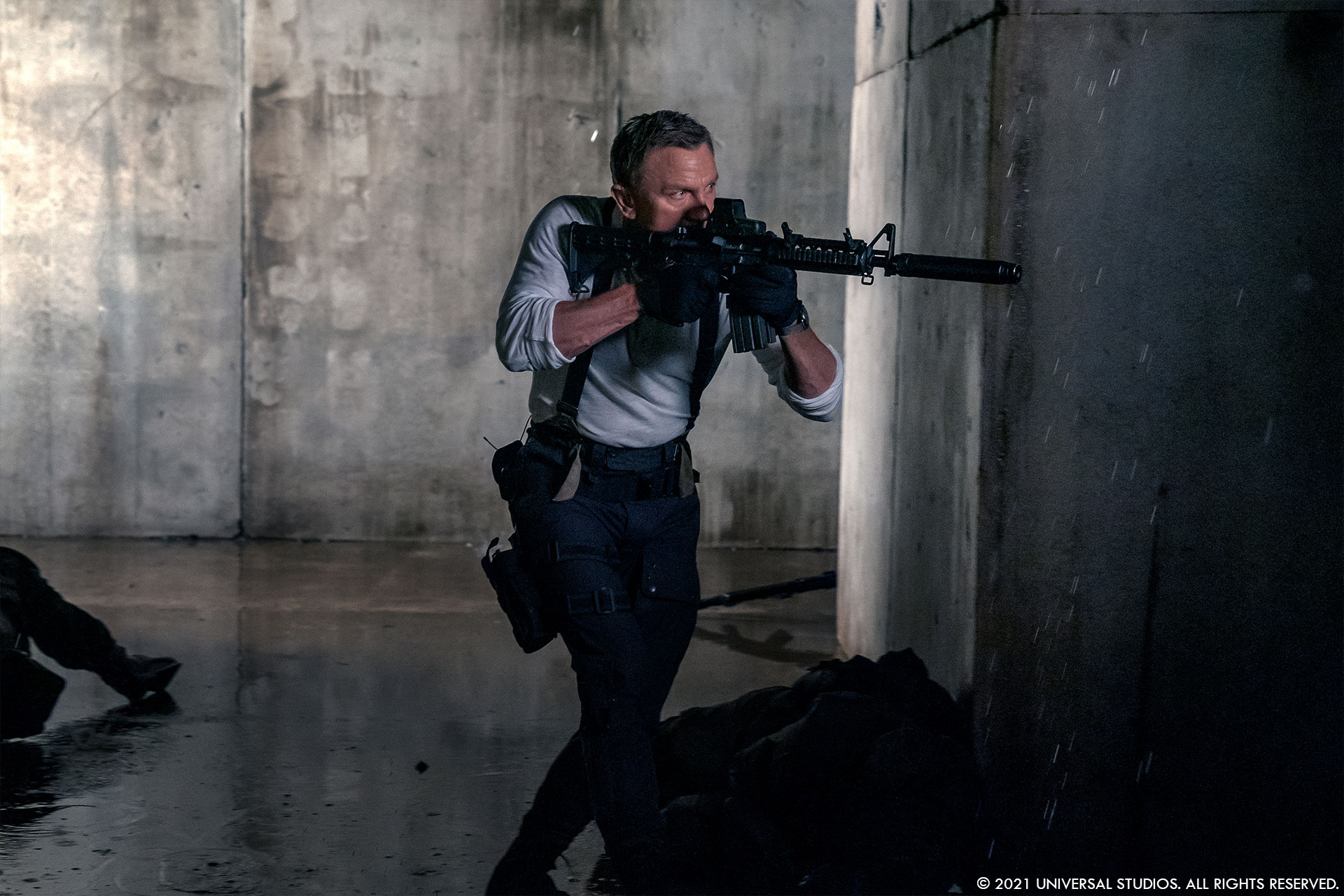
The final sequence ends with lots of explosions. Can you explain in detail about their creation?
Charlie Noble // Chris set off some of the largest explosions on Salisbury Plain that I’ve ever seen, these provided invaluable scale and detail that we mixed into our CG explosions that needed to follow the shape of our CG missile silos. DNEG reproduced the huge explosions to engulf the island, incinerating the deadly Heracles nanobots.
Joel Green // Cary had a clear idea of the type of artillery he wanted to see deployed for the final sequence and we gathered a lot of references to guide our FX team. Ioanna Mailli and Mick Harper did most of the heavy lifting for the island destruction, supervised by Adrian Thompson. All the FX work utilised Houdini and having an FX setup that was procedural and flexible was key as the timing and arc of each missile was debated and directed into place to give the iconic finale as big an impact as possible. The deadline was really tight for these shots and the whole team at DNEG went above and beyond to make them a success.
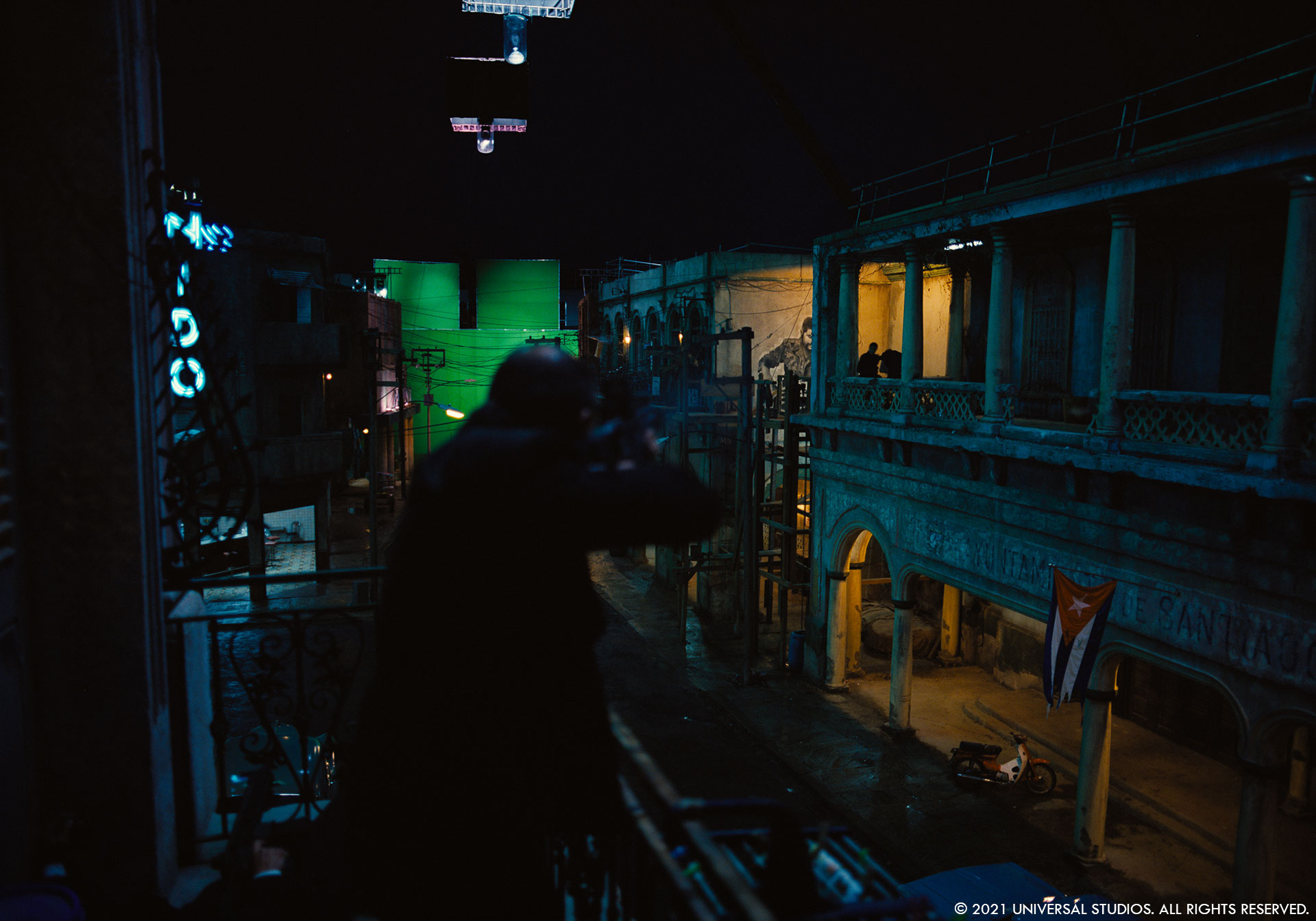
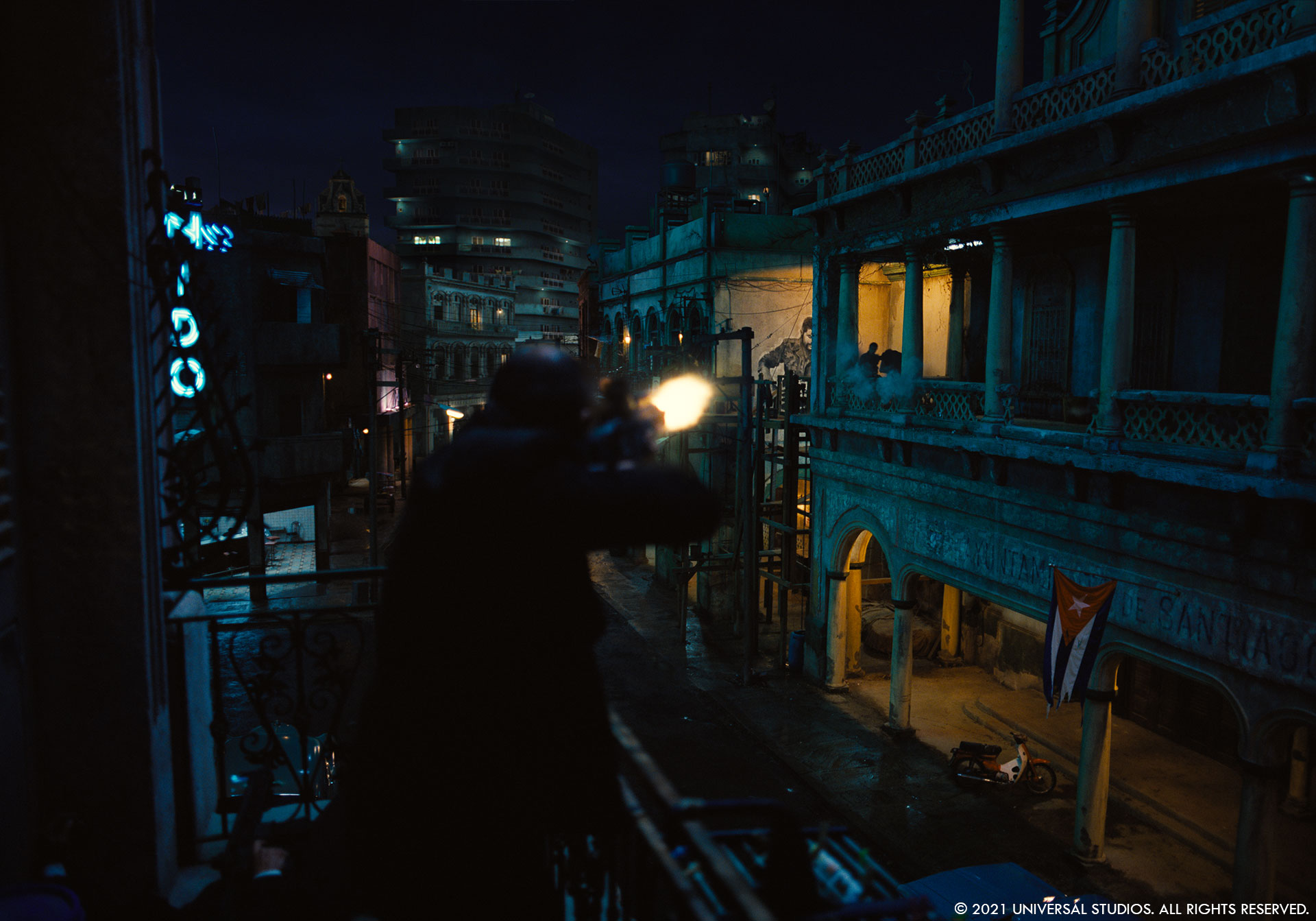
Did you want to reveal to us any other invisible effects?
Lots of subtle enhancements such as Cinesite’s bubbles inside the sinking trawler set to sell the roll of the boat and add to the frenetic jeopardy, their iridescent deadly mist in the Spectre party, Framestore’s lovely bees in Safin’s poison garden, ILM’s face reps, DNEG’s Cuba street extensions, I could go on… 🙂
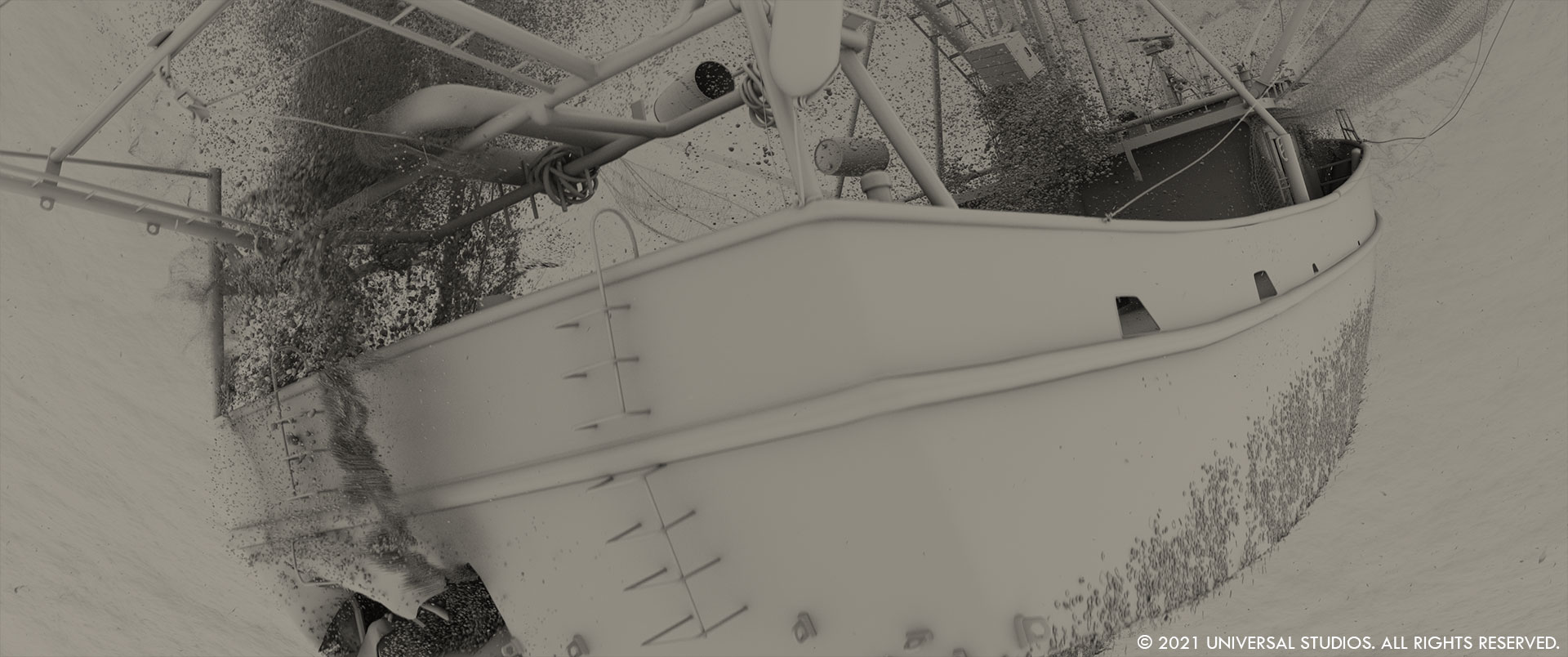
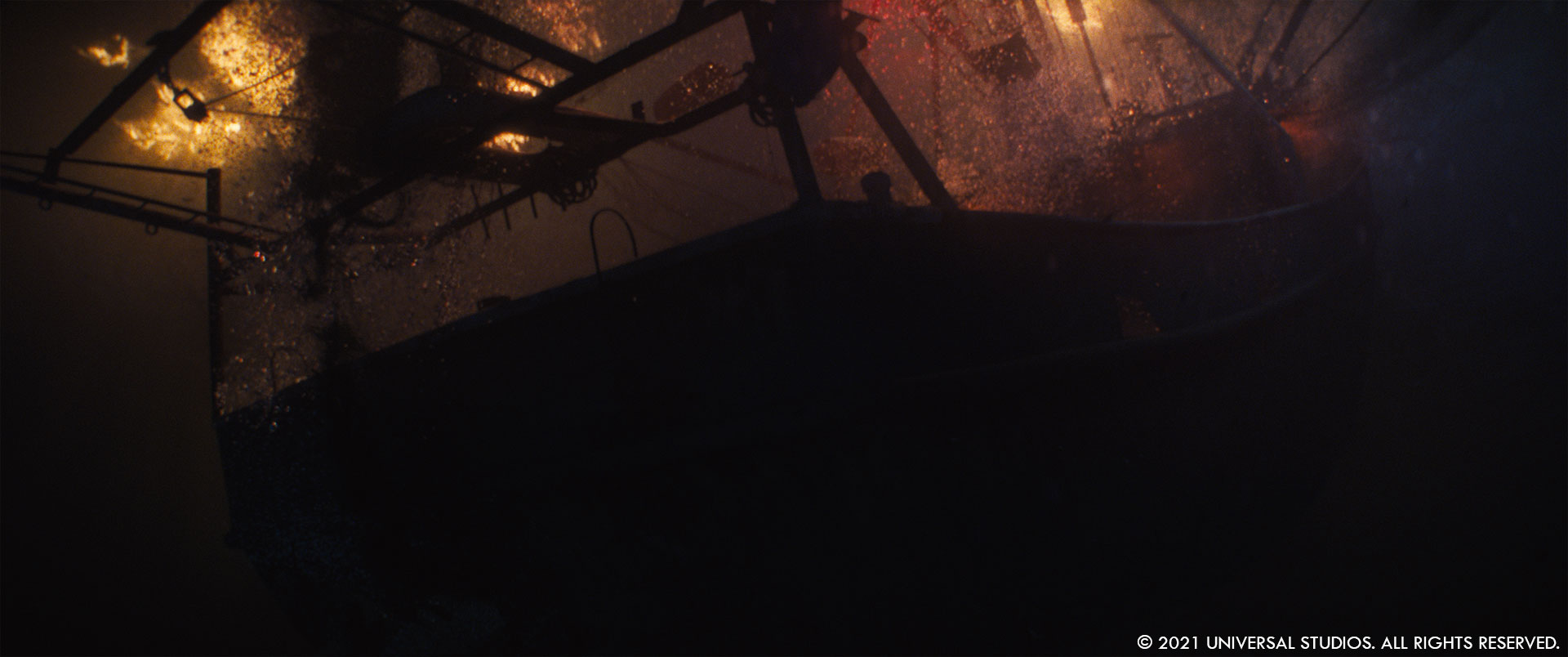
What was your favourite sequence or shot and which was the most challenging?
All of it! The exterior shots of the trawler sinking required lots of water and fire simulations both under and on top of the water. We stayed faithful to Linus’ lighting of the real boat in Jamaica and kept just the fading red lights from the trawler and surface fires to support the narrative.
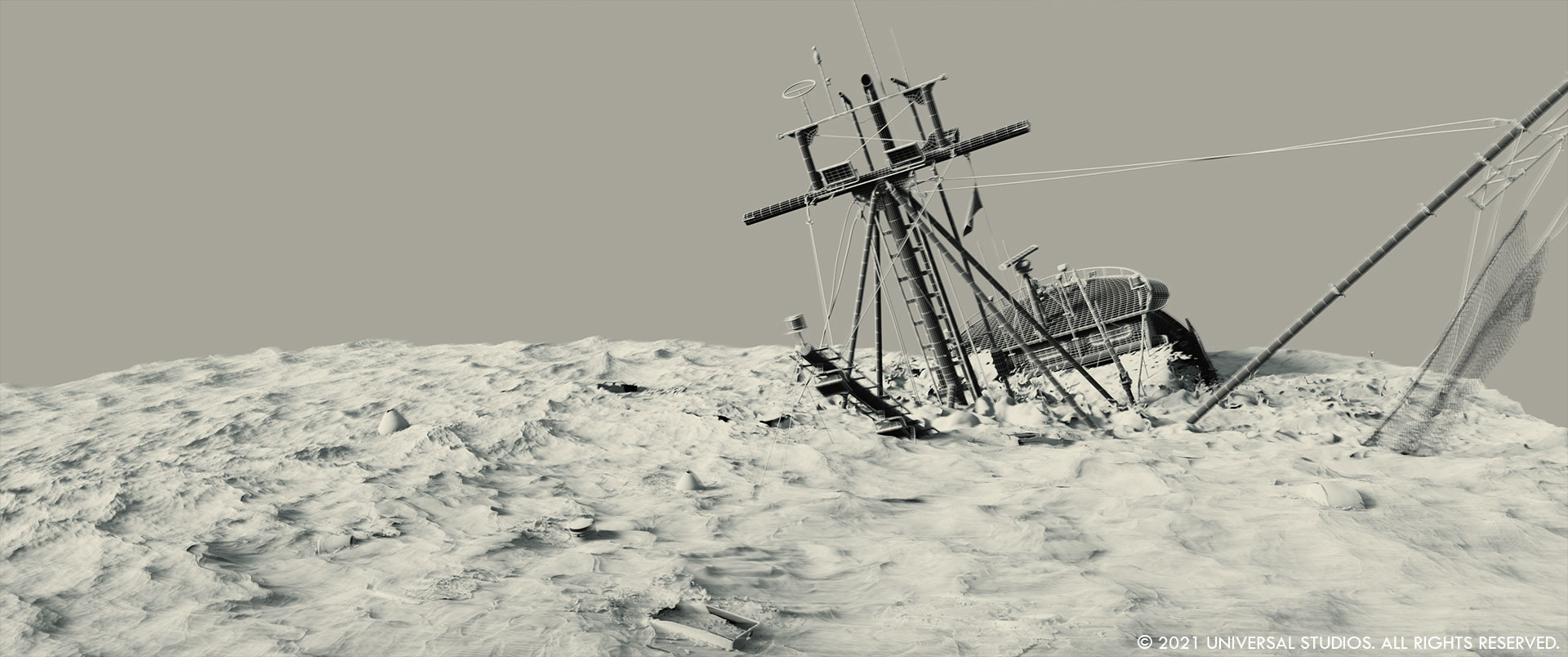
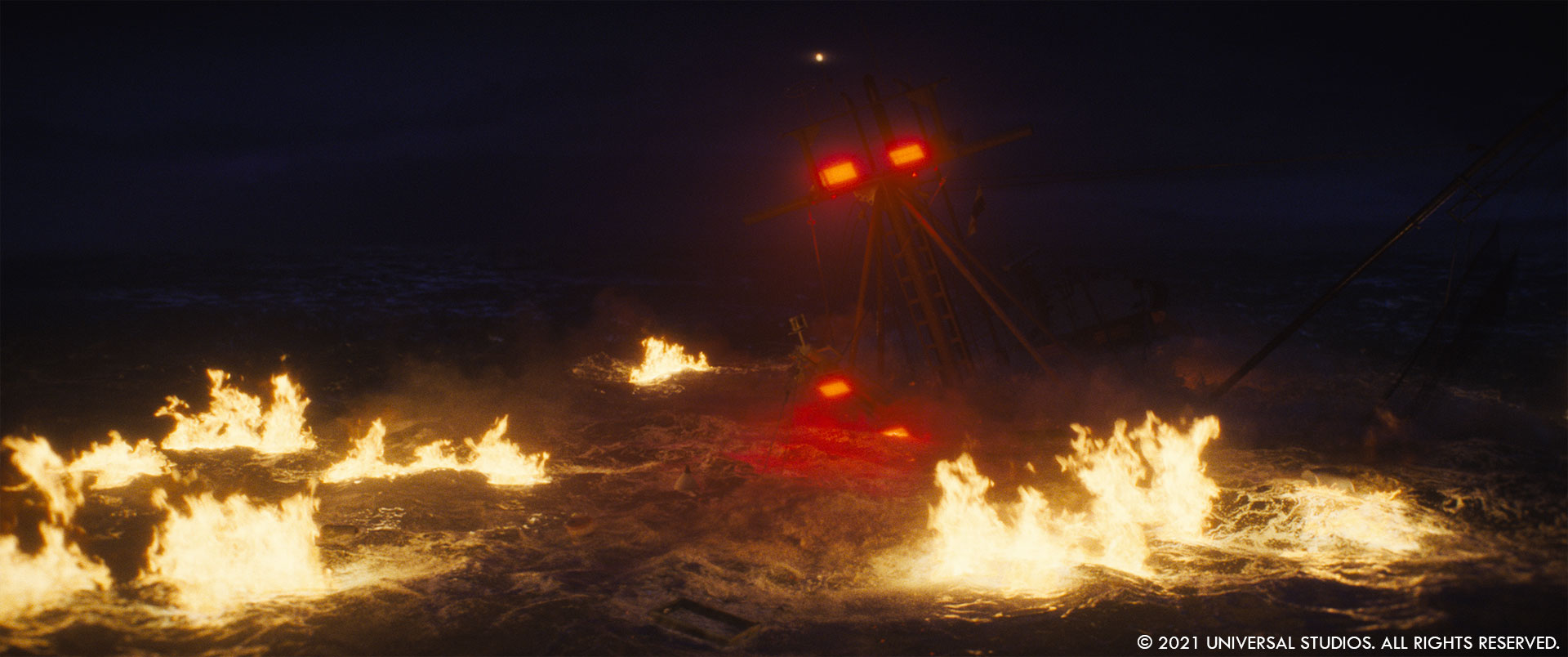
How long have you worked on this show and what is your best memory?
I started in October 2018. My best memory was seeing it on the big screen in the Albert Hall 🙂
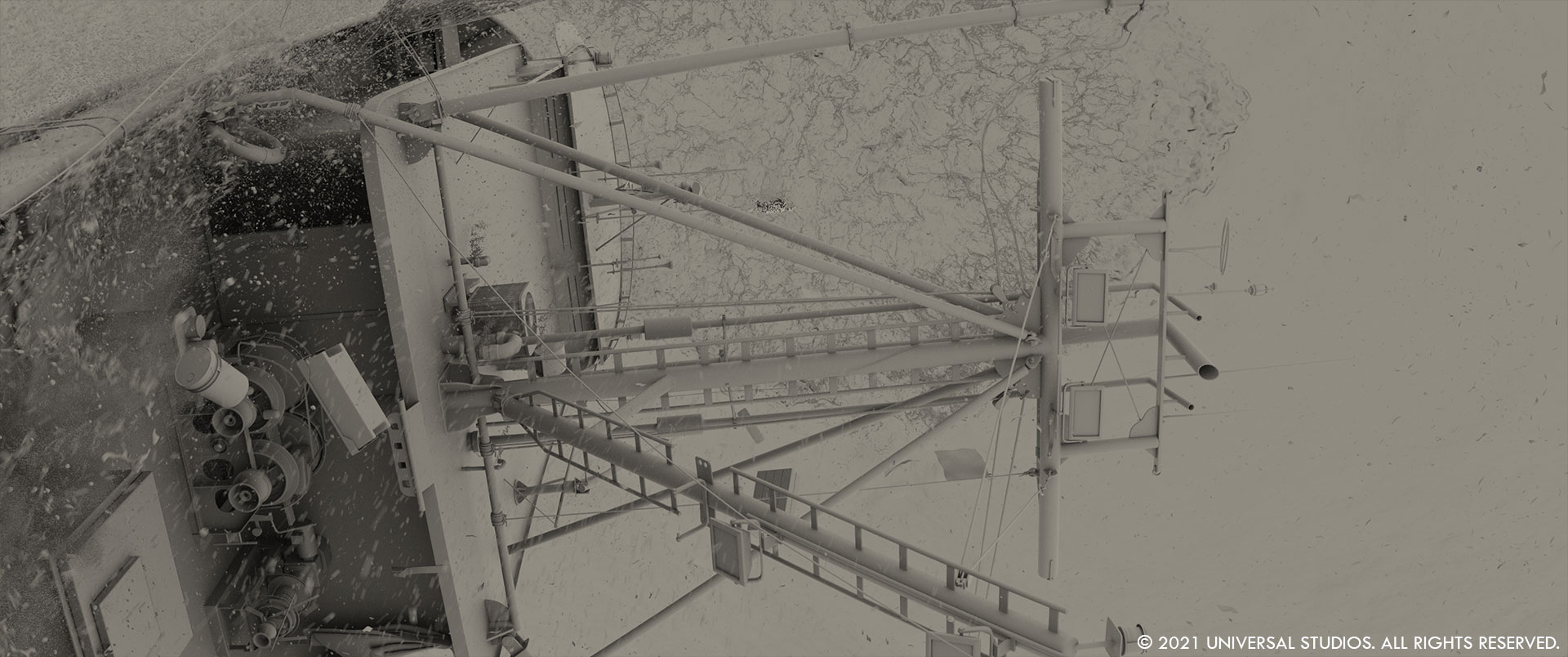
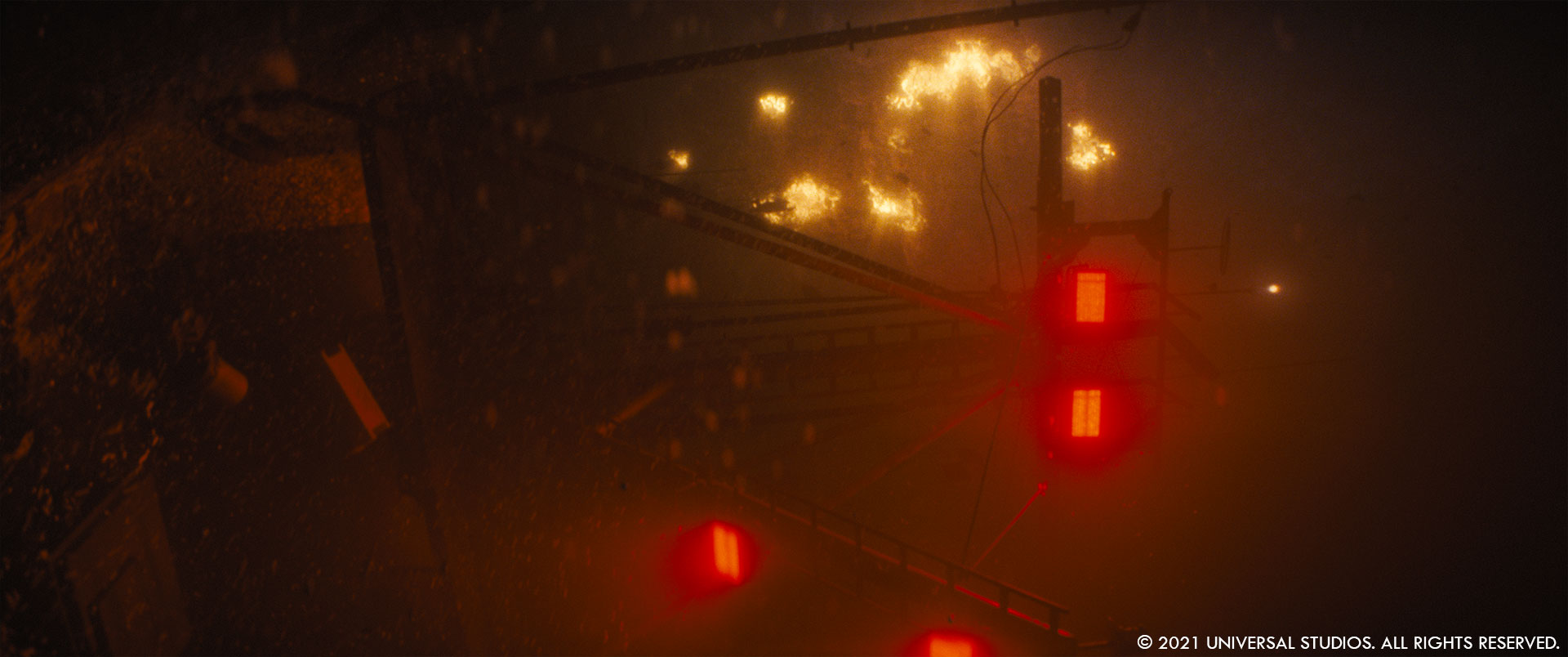
What’s the VFX shots count?
1487 shots in the film.
What is your next project?
I originally intended on having a bit of a breather but have ended up with my fingers in a few pies at the moment, which is nice. I like pies.
A big thanks for your time.
WANT TO KNOW MORE?
Cinesite: Dedicated page about No Time To Die on Cinesite website.
DNEG: Dedicated page about No Time To Die on DNEG website.
Framestore: Dedicated page about No Time To Die on Framestore website.
© Vincent Frei – The Art of VFX – 2021





